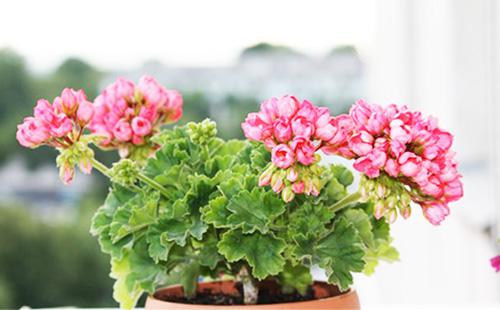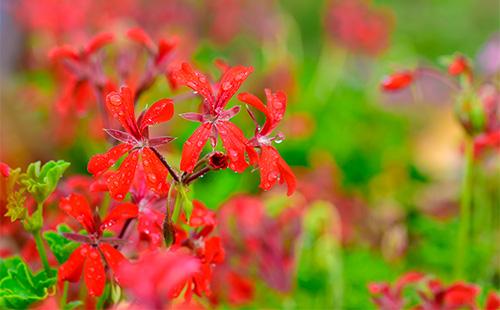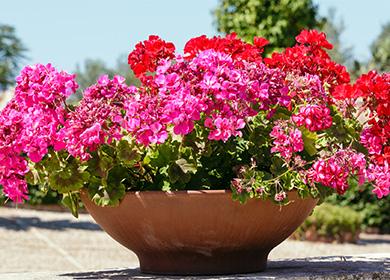The content of the article
Tulip geranium bred in 1966 in Boston. The variety is obtained by hybridization. But there is an opinion that he appeared by chance as a result of a mutation of one of the species.
View description
The main difference between tulip-shaped geraniums from other species is the unusual structure of the flowers. The buds are small, not more than 1 cm. They look like a tulip bud. Inflorescences form 20-50 flowers. Only one inflorescence is formed on one stalk.
Different varieties differ in color, growth rate, leaves and flowers. There may be a different number of petals. Usually in one flower there are from six to nine. The edges of the petals are even or with small curly notches. The outside of the flower is paler, the inside is brighter. The colors are dominated by red tones. There are varieties with delicate pink flowers and rich burgundy.
The most interesting varieties
Tulip geranium is represented by plants of different colors and sizes. The characteristics of the most interesting of them are given in the table.
Table - Varieties of tulip-shaped geraniums, their characteristics
| Grade | Inflorescences | Leaves | Plant type |
|---|---|---|---|
| Helma | - Large up to 40 flowers; - color reddish orange | - Grassy green color; - uneven edges | - Dwarf |
| Conny | - Medium size; - oblong shape of flowers; - Red color | - Emerald; - velvet surface; - carved edges | - Dwarf |
| Emma fran benqtsbo | - Medium size; - elongated shape of flowers; - white with a pinkish tint | - Elongated; - soft green color | - Tall, bushy up to 80 cm. |
| Patricia Andrea | - reddish pink | - carved; - dark; - glossy surface | - Medium |
| Red pandora | - Lush; - pink with streaks of red | - Emerald; - velvety | - Medium |
Care for tulip-shaped geraniums: what to consider
How to care for tulip-shaped geraniums? The conditions are almost identical to ordinary geraniums. Care differs somewhat during the flowering period. The plant is unpretentious and easy to grow.
- Lighting. They are placed in brightly lit places without direct sunlight. They do not put it in the shade - the plant stretches out, fades, ceases to bloom. For year-round flowering, they organize backlighting with phytolamps.
- Temperature. In the summer, in the range from 21 ˚С to 26 ˚С. In winter, the temperature is lowered to 14–16 ° C. He does not tolerate temperature jumps, begins to hurt.
- Watering. Between watering, the surface dries up by one and a half centimeters. Excess moisture leads to rotting of the roots. Drying of an earthen coma is also not allowed - a lack of water affects the decorative qualities of geraniums.In winter, water less often than in summer - just one watering per week is enough. It is better to use the lower method: water is poured into the pan, after half an hour the excess is drained.
- Air humidity. Full growth is favored by dry air. Spraying harms.
- Top dressing. You can feed a tulip-shaped geranium no more than twice a month. The fertilizer should contain a minimum of nitrogen, an increased concentration of phosphorus and potassium. Nitrogen stimulates the recruitment of green mass. With its excess in the soil, geranium does not bloom. According to expert gardeners, the flower responds well to natural organic fertilizing - the introduction of crushed shells, nettle infusion, and sleeping tea.
- The soil. The optimal soil composition is peat and garden soil with the addition of coarse sand. Landing in ready-made store soil mixes is allowed.
- Transfer. Transplanted into a larger pot as the roots grow. The need for transplantation is determined by the germination of the roots through the drainage holes. Choose a small clay or wooden pot. In plastic grows poorly. If several bushes of geranium are planted in one container at once, the pot is taken free. Caring for tulip-shaped geraniums after transplantation includes regular watering, keeping warm with shading from sunlight. Top dressing in the first two to three weeks is stopped.
Cropping Features
Pruning tulip-shaped geraniums is a mandatory procedure to preserve its decorative effect. Timely pruning and pinching stimulate branching, contribute to a more friendly formation of flower buds.
At the very beginning of spring or at the end of the depot pinch growth points at the level of the sixth leaf. Strongly elongated stems shorten, gone inflorescences cut. Five to six buds are left on the stem. Slices are powdered with coal powder. After pruning, the geranium is fed so that it recovers faster.
Sterile instruments are used for trimming. Scissors or a knife are enough to scald with boiling water and wipe with alcohol. You can pinch only with clean hands - bacteria easily penetrate through the slices, the plant begins to hurt. Instead of coal powder, you can take ordinary brilliant green for processing slices.

Breeding methods
To propagate tulip-shaped geraniums, a vegetative and seed method is used. Only sown seeds are sown. Ordinary geraniums will grow from the seeds obtained from your plant. Hybrid varieties are characterized by the loss of variety characteristics during seed propagation.
- Bush division. When transplanting a bush of geraniums can be planted. Shared by adult, overgrown bushes. The plant is removed from the pot, freed from the roots, carefully divided into several parts and planted. At the same time, pruning is performed to stimulate the growth of side shoots.
- Cuttings. It is very simple to propagate the tulip-shaped geranium by cuttings. When grafting all the features of the mother plant are fully preserved. Reproduction is carried out in spring or autumn. For convenience, combine it with pruning. The lower cut should be straight, cut a twig directly under the lower kidney. Cuttings are dried for a couple of hours and only then planted in the ground.To root a tulip-shaped geranium, you need to maintain a stable high temperature and good light. Until the first roots appear, the cuttings are kept under cover. The roots appear within a month. You can try to propagate geranium leaf, but this method rarely gives positive results.
- Scions. The shoot will take root faster than the stalk. To obtain processes, root formation is stimulated even on the mother plant. Two weeks before the cuttings, a healthy shoot is chosen. Throughout its length, annular incisions are made under the kidneys. After some time, an influx with root tubercles forms at the incision site. Such cuttings take root very quickly.
- Seeds. Seeds germinate quickly - the first entries appear on the fifth day. They are sown in February in a loose sand-peat mixture with the addition of humus. Seeds do not deepen much, spray the soil from the spray. Until emergence, they are kept under the film, in good light. At the stage of formation of three true leaves, seedlings dive together with a lump of earth.

Frequent illnesses ...
Tulip geraniums are susceptible to a number of diseases. It is infected through poor-quality soil, pests, from neighboring flowers. Illiterate care only exacerbates the disease. Signs, names of diseases are given in the table.
Table - Tulip Disease Geranium Diseases
| Title | Manifestations | Treatment |
|---|---|---|
| Testing | - Cork brown growths on the back of the leaves | - Reduce air humidity; - carry out preventive treatment with insecticides from pests; - regulate watering and top dressing |
| Viruses | - discoloration of the foliage; - yellowness of veins; - brown color of leaves; - growth inhibition | - The plant is thrown away (the virus is transmitted during cuttings) |
| Bacteriosis | - Withering of individual leaves; - leaves turn yellow; - black rot on the basis of shoots; - oily spots | - The plant is destroyed, the neighboring ones are treated with fungicides |
| Stem and root rot | - Decay of the root neck; - rotting and softening of the roots | - Treat the roots with fungicides; - replace the soil; - sprayed with drugs "Fitolavin" "Fitosporin", "Bactofit" |
| Verticillus wilting | - lethargy, drooping leaves; - coarsening of blood vessels at the cut | - The plant is destroyed |
| Spotting | - First dark green, then brownish spots with a protruding edge | - Reduce humidity; - remove the affected leaves; - sprayed with any fungicides |
| Gray rot | - Wet brownish spots; - gray coating | - Remove the affected parts; - reduce humidity; - treated with Fitosporin |
Most diseases can be prevented by maintaining a favorable microclimate. Additionally, prophylactic treatments with small doses of fungicides are recommended. The optimal drug is Fitosporin.
... and pests
Pests move from plants recently brought into the house and fall through the windows. The larvae of some insects may be dormant in the soil. Excessive dampness of the soil, low air humidity provokes their active development. The main pests of geraniums, signs of their appearance and methods of control are collected in the table.
Table - Pests of Tulip Geraniums
| Insect name | Signs of occurrence | Control measures |
|---|---|---|
| Multi-claw ticks | - Slowed growth of upper leaves; - coarsening and twisting of young leaves; - brown crust on petioles | - In case of minor damage, soap treatment; - with a strong spread of pests - spraying with the preparations "Vermitek", "Anticlesch", "Jet" |
| Spider mites | - Spider web; - yellow blotches on the foliage; - dried areas on the leaves | - Treatment with soapy water; - processing means "Akarin", "Lightning" |
| Mushroom mosquitoes | - Rotting stems at the base; - white, translucent larvae in the stems | - Processing "Fly-eater", "Thunder-2", "Aktara" |
| Thrips | - Cork growths on the leaves; - deformation of new leaves; - curvature of the growth point; - holes in the petals; - boring of the edges of the petals | - Three-time spraying with insecticides "Commander", "Bison", "Actellik" |
| Aphid | - Curly and yellow leaves; - sticky, sticky discharge | - Washing with soapy water; - use of insecticides |
| Whitefly | - Adult insects with white wings; - pale yellow larvae on the back of the leaves; - yellowness of leaves; - the appearance of adhesive secretions | - Treatment with a solution of potassium soap; - spraying with insecticides "Tanrek", "Inta-vir", "Spark" |
Growing tulip-shaped geraniums at home is a simple and interesting task. If you comply with the basic requirements of the flower to the conditions of detention, it will bloom almost all year round.

